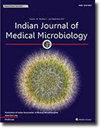CLINICO-LABORATORY profile of scrub typhus cases among adults presenting with acute febrile illness
IF 1.4
4区 医学
Q4 IMMUNOLOGY
引用次数: 0
Abstract
Purpose
To determine the frequency and clinico-epidemiological profile of patients with scrub typhus and to assess the performance characteristics of an ICT based rapid assay for its diagnosis.
Methods
This was an observational cross-sectional study conducted on 175 adults ≥18 years of age presenting with acute onset of fever (temperature >38 °C) for <14 days with any of the following features: eschar, rash, lymphadenopathy, hepatosplenomegaly, jaundice and multi-organ involvement. Immunocompromised patients, such as those with HIV/AIDS, malignancy, patients on cytotoxic drugs and on systemic corticosteroid therapy were excluded from the study. Cases were recruited from medicine wards of Lok Nayak Hospital. Serum from the cases was tested for Orientia tsutsugamushi specific IgM antibody by ELISA and rapid assay. The performance characteristics of rapid assay was evaluated by comparing it with ELISA as the reference standard.
Results
Out of 175 cases, 36 (20.6 %) were reactive for scrub typhus IgM ELISA, while 139 (79.4 %) were non-reactive. Maximum number of scrub typhus cases were in the age group of 21–30 years (41.7 %) with both genders affected equally. Majority of the scrub typhus cases resided in urban areas (69.4 %), belonged to lower middle class (38.9 %) and were seen between the monsoon months of July and October (75 %). Eschar, lymphadenopathy, jaundice, ascites, ARDS, myocarditis, DIC, raised LDH, raised ALP, hyperbilirubinemia, hyperphosphatemia, hypoalbuminemia and leucocytosis were found to be significantly associated with scrub typhus. The sensitivity and specificity of the scrub typhus IgM rapid assay when compared to IgM ELISA was 22.2 % and 100.0 %, respectively, with low kappa value of 0.312.
Conclusion
The frequency of scrub typhus in AFI was found to be 20.6 %. In view of the poor sensitivity, the RDT used in our study cannot be recommended as the screening assay for serodiagnosis of scrub typhus.
以急性发热性疾病为表现的成人恙虫病病例的临床-实验室分析
目的了解恙虫病患者的发病频率和临床流行病学特征,评价基于ICT的恙虫病快速诊断方法的性能特点。方法:这是一项观察性横断面研究,对175名年龄≥18岁的成年人进行研究,他们表现为急性发热(体温38°C)持续14天,并伴有以下任何特征:结痂、皮疹、淋巴结病、肝脾肿大、黄疸和多器官受累。免疫功能低下的患者,如艾滋病毒/艾滋病患者、恶性肿瘤患者、使用细胞毒性药物的患者和接受全身皮质类固醇治疗的患者被排除在研究之外。病例是从Lok Nayak医院的内科病房招募的。采用ELISA和快速测定法检测恙虫病东方体特异性IgM抗体。以ELISA为参比标准,评价快速检测方法的性能特点。结果175例恙虫病IgM ELISA检测阳性36例(20.6%),阴性139例(79.4%)。恙虫病病例以21-30岁年龄组最多(41.7%),男女发病人数相同。丛林斑疹伤寒病例主要集中在城市地区(69.4%),属于中下层(38.9%),发生于7月至10月季风月份(75%)。疥疮、淋巴结病、黄疸、腹水、ARDS、心肌炎、DIC、LDH升高、ALP升高、高胆红素血症、高磷血症、低白蛋白血症和白细胞增多与恙虫病有显著相关性。与IgM ELISA相比,恙虫病IgM快速检测的敏感性和特异性分别为22.2%和100.0%,kappa值较低,为0.312。结论AFI中恙虫病患病率为20.6%。本研究采用的RDT检测方法敏感性较差,不建议作为恙虫病血清诊断的筛查方法。
本文章由计算机程序翻译,如有差异,请以英文原文为准。
求助全文
约1分钟内获得全文
求助全文
来源期刊

Indian Journal of Medical Microbiology
IMMUNOLOGY-
CiteScore
2.20
自引率
0.00%
发文量
154
审稿时长
73 days
期刊介绍:
Manuscripts of high standard in the form of original research, multicentric studies, meta analysis, are accepted. Current reports can be submitted as brief communications. Case reports must include review of current literature, clinical details, outcome and follow up. Letters to the editor must be a comment on or pertain to a manuscript already published in the IJMM or in relation to preliminary communication of a larger study.
Review articles, Special Articles or Guest Editorials are accepted on invitation.
 求助内容:
求助内容: 应助结果提醒方式:
应助结果提醒方式:


